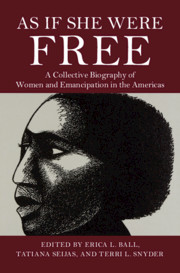Book contents
- As If She Were Free
- As If She Were Free
- Copyright page
- Dedication
- Contents
- Figures
- Contributors
- Elizabeth Catlett and the Form of Emancipation
- Acknowledgments
- Introduction
- Part I Claiming Emancipation during the Rise of New World Slavery
- Part II Experiencing Freedom during Slavery’s Expansion
- 7 Judith and Hannah: Eighteenth-Century Florida, South Carolina, and Virginia (US)
- 8 Sarah Chauqum, Eighteenth-Century Rhode Island and Connecticut (US)
- 9 Marion, Eighteenth-Century Natchitoches, Louisiana (US)
- 10 Anna Maria Lopes de Brito, Eighteenth-Century Minas Gerais (Brazil)
- 11 Juana Ramírez, Eighteenth-Century Oaxaca, New Spain (Mexico)
- 12 Juana María Álvarez, Eighteenth-Century New Granada (Colombia)
- 13 María Hipólita Lozano, Eighteenth-Century Lima (Peru)
- Part III Envisaging Emancipation during Second Slavery
- Part IV Enacting Emancipation in the Aftermath of Slavery
- Bibliography
- Index
7 - Judith and Hannah: Eighteenth-Century Florida, South Carolina, and Virginia (US)
from Part II - Experiencing Freedom during Slavery’s Expansion
Published online by Cambridge University Press: 24 September 2020
- As If She Were Free
- As If She Were Free
- Copyright page
- Dedication
- Contents
- Figures
- Contributors
- Elizabeth Catlett and the Form of Emancipation
- Acknowledgments
- Introduction
- Part I Claiming Emancipation during the Rise of New World Slavery
- Part II Experiencing Freedom during Slavery’s Expansion
- 7 Judith and Hannah: Eighteenth-Century Florida, South Carolina, and Virginia (US)
- 8 Sarah Chauqum, Eighteenth-Century Rhode Island and Connecticut (US)
- 9 Marion, Eighteenth-Century Natchitoches, Louisiana (US)
- 10 Anna Maria Lopes de Brito, Eighteenth-Century Minas Gerais (Brazil)
- 11 Juana Ramírez, Eighteenth-Century Oaxaca, New Spain (Mexico)
- 12 Juana María Álvarez, Eighteenth-Century New Granada (Colombia)
- 13 María Hipólita Lozano, Eighteenth-Century Lima (Peru)
- Part III Envisaging Emancipation during Second Slavery
- Part IV Enacting Emancipation in the Aftermath of Slavery
- Bibliography
- Index
Summary
Hannah was the daughter of a woman named Judith, an Apalachee Indian raised in Spanish Florida who was taken captive by the English in 1704 and sold as a slave in South Carolina and taken to Virginia. Judith remained enslaved by Coleman until her death. In the 1770s, some of Judith’s children claimed freedom before the courts, an act that propelled Virginia’s legal system in a long, drawn-out dialogue over the legacies of the Indian slave trade, the legality of Indian slavery, and the rights of slave plaintiffs before the courts. For Hannah and her co-plaintiffs in the Robin v. Hardaway case, this singular facet of their identity shaped their claims to freedom. Establishing connection to a maternal Indian ancestor continued to sustain litigation for subsequent generations of their families – well into the nineteenth century – even as regimes of race and slavery shifted around them. While their lived experiences in a multiracial world of slavery and freedom grew increasingly complex, Judith, Hannah, and others deployed specific, selective, and skillful strategies to self-fashion narratives about race, rights, and family in their efforts to claim freedom.
- Type
- Chapter
- Information
- As If She Were FreeA Collective Biography of Women and Emancipation in the Americas, pp. 131 - 150Publisher: Cambridge University PressPrint publication year: 2020

